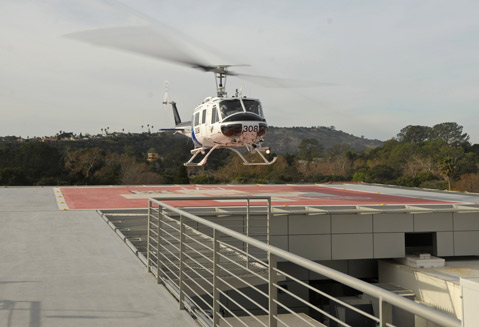When Time Is of the Essence
Saving Lives and Minimizing Hospital Helipad's Impact on Neighborhood

In the case of critically ill or injured patients, time is vitally important. Having immediate access to appropriate care can make all the difference in saving lives and impacting a survivor’s long-term outcome.
For ten years now, Santa Barbara Cottage Hospital has operated as the region’s only Level II trauma center. Such certification required developing and assembling an organized and experienced trauma team to respond 24/7 to extreme emergencies. When notified that a critically injured patient is en route to the hospital, a process of “trauma activation” immediately goes into place. This system mobilizes a core group of medical personnel to be at the ready the instant the patient arrives.
It goes beyond the very capable emergency department staff to involve trauma surgeons and other surgical specialists, anesthesiologists, operating room and critical care nurses, and CT, x-ray and respiratory staff. It means readying the surgical suite in the middle of the night and mobilizing supplies, blood, and other essential resources. Time is of the essence in these situations, and not a moment is to be wasted.
Helicopter transfers of critical patients are part of that important window of time – whether from other hospitals in the region, from the back-country, or from the ocean. And a rooftop helipad was always part of the plan for Santa Barbara Cottage Hospital as it undertook the design, funding, and complicated approval process for rebuilding the hospital to new state-mandated earthquake safety standards.
Planning included assessing the environmental impact, projecting the number of landings to the best of our ability, and conducting professional acoustical studies with test helicopter “fly-bys.” The helipad was initially approved in 2001. However, with the pending development of a new hospital, the permit was extended and approved again in 2005 as part of the new hospital approval.
On February 3, 2012, following a series of training and practice landings with local helicopter companies along with County Fire and Search & Rescue, the helipad received official authorization to operate on the rooftop of the newly constructed hospital on the Pueblo/Oak Park Lane/Junipero block. The initial number of landings has exceeded expectations. In the first week alone, we had 13 landings on the pad – significantly more than anticipated, and more than had been transported on average to the Santa Barbara Airport or La Cumbre Junior High School for ambulance transfer to the hospital. The numbers have leveled off considerably since then to five per week, but the number of landings has understandably raised significant concern in the neighborhood.
As a result, we immediately held a neighborhood meeting and have taken a number of steps to meet the goals of saving lives and minimizing the impact on the neighborhood. One of the most important things we’ve recognized is the need to emphasize and reinforce the official flight path to the new helipad. This Caltrans-approved noise-abatement route calls for flights to come up or down the 101 corridor, to turn in between Junipero and Pueblo streets, and go immediately to the landing pad. We have made it clear that hovering in the neighborhood is not acceptable; that advance notice of a proposed landing is mandatory; and that helicopters, once landed, may not leave their crew at the hospital and go off to refuel and return to land again.
To be sure that protocol is being followed, we are observing and videotaping each landing and take-off, and working diligently with out-of-area air ambulance companies to reinforce the required flight path and other rules related to landings at the hospital. Already we have suspended privileges for one helicopter operator who has not followed the established rules.
The original 2001 and 2005 estimates of helipad activity ranged from one to three landings per week. However, the environmental impact report also assumed a worst-case scenario of two landings per night. Furthermore, since 2005, there have been significant advances in medicine and Cottage has developed additional clinical programs that are unique to the region and are impacting the number of transports that can be expected.
In the last five years, specifically, Cottage has developed an interventional neurovascular program that is making a huge difference for patients with strokes, brain hemorrhages, and brain aneurysms, and the development of Cottage Children’s Hospital’s advanced pediatric subspecialty services is helping children who previously had to seek care outside the Central Coast.
Every helicopter transport since February 3 has been reviewed for appropriateness. Each and every one of the flights has been activated because of a true medical emergency involving a patient. They have included vehicular trauma, pediatric bacterial meningitis, subarachnoid hemorrhage – each requiring immediate life-saving treatment. Our goal in accepting transports is to help save lives and improve medical outcomes for patients.
We plan to hold a second neighborhood meeting to talk about this issue, to report on actions taken since February 3, and to listen to our neighbors. We acknowledge the impact on the neighborhood and appreciate all those who have shared their thoughts, support, and concern. The meeting will be held Tuesday evening, March 13, 6:00 to 7:00 pm in Burtness Auditorium at SBCH. If you have questions or concerns at any time, you can call our project management hotline at (805) 569-8917.



